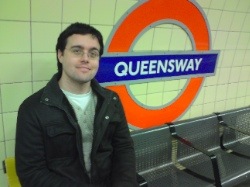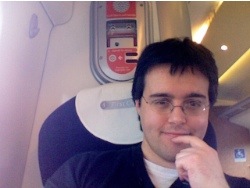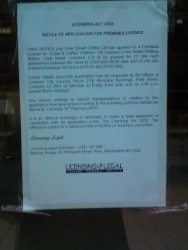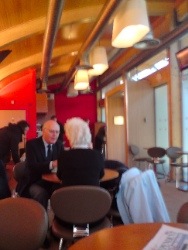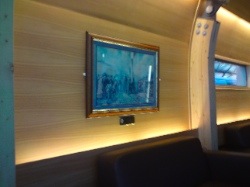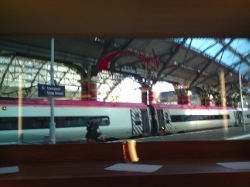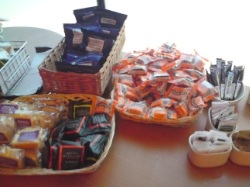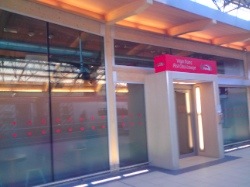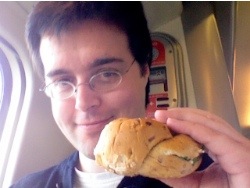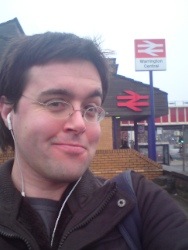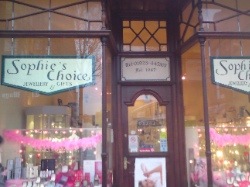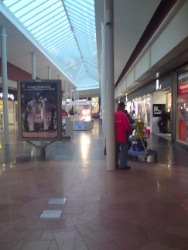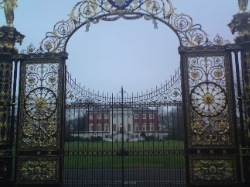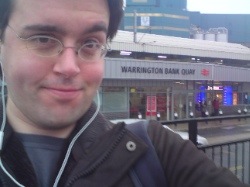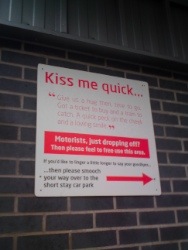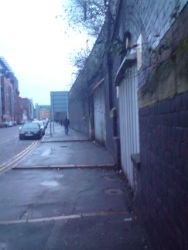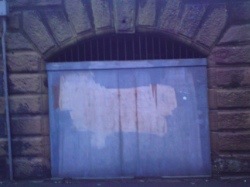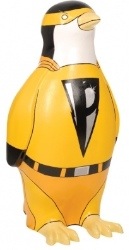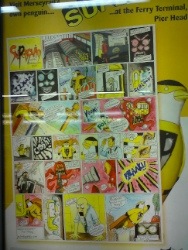"I am old, Father William," the young man said
"And I find it so hard to start;
"And yet I am up and out of my bed
"Does this mean it is time for a Tart?"
Charles Lutwidge Dodgson, a.k.a Lewis Carroll, is wrapped up in a place - Oxford. It's almost impossible to visualise the Reverend without thinking of him punting on the Cherwell, reading in the Bodleian, striding across the Quad at Christ Church, trying to persuade little girls to do handstands on the meadows. He is tied up in the academia and mythology of the city.
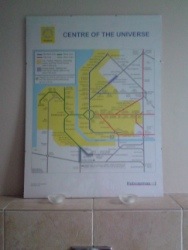 So it came as a surprise to me to learn that Dodgson originally came from oop North - to be specific, from the village of Daresbury in Cheshire. I learnt of this from Graeme Currie's Centre of the Universe, which I've got in my toilet. This might seem a bit disrespectful, but it's quite the opposite; it's my belief you should always have something interesting to capture your attention while you pee, and the map does the job admirably.
So it came as a surprise to me to learn that Dodgson originally came from oop North - to be specific, from the village of Daresbury in Cheshire. I learnt of this from Graeme Currie's Centre of the Universe, which I've got in my toilet. This might seem a bit disrespectful, but it's quite the opposite; it's my belief you should always have something interesting to capture your attention while you pee, and the map does the job admirably.
Anyway, the poster replaces the names on the Merseyrail map with famous people, and I was surprised to see Lewis Carroll on there where Runcorn East should be:
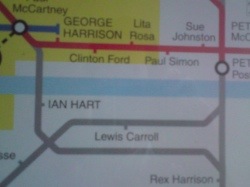 I've been a big Lewis Carroll fan for years, ever since my Aunt Rosina bought me his complete works when I was a child. His mathematical knots cause mental contortions that would vanquish a supercomputer; Sylvie and Bruno is a quite insane novel about a couple of fairies in Victorian England, which confuses and delights in equal turns; and The Hunting of the Snark is just genius nonsense.
I've been a big Lewis Carroll fan for years, ever since my Aunt Rosina bought me his complete works when I was a child. His mathematical knots cause mental contortions that would vanquish a supercomputer; Sylvie and Bruno is a quite insane novel about a couple of fairies in Victorian England, which confuses and delights in equal turns; and The Hunting of the Snark is just genius nonsense.
But of course, my heart belongs to Alice. Alice's Adventures in Wonderland and Through the Looking-Glass are dazzling, demented novels which ensnare you no matter how old you are. I reread them every couple of years, and each time I find some new nuance, some strange little kink, some tiny detail which I had missed from before. Finding out that such a brilliant writer was born so close by meant just one thing: I would have to visit.
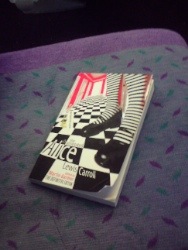 I came prepared with my copy of The Annotated Alice, edited by Martin Gardner. This is a brilliant edition of the Alice books, with footnotes explaining references, what songs are being parodied in the novel's verses, who inspired the characters and so on. It's a bit po-faced and humourless at times, and you do start to wonder if Lewis Carroll ever used his imagination or if, according to this, everything was a parody, caricature or satirical comment. I look forward to there one day being The Annotated Harry Potter, where Hogwarts is outed as a symbol of Britain's political decline, with Voldemort as Tony Blair. (Actually that's rather good. Copyright! Copyright!).
I came prepared with my copy of The Annotated Alice, edited by Martin Gardner. This is a brilliant edition of the Alice books, with footnotes explaining references, what songs are being parodied in the novel's verses, who inspired the characters and so on. It's a bit po-faced and humourless at times, and you do start to wonder if Lewis Carroll ever used his imagination or if, according to this, everything was a parody, caricature or satirical comment. I look forward to there one day being The Annotated Harry Potter, where Hogwarts is outed as a symbol of Britain's political decline, with Voldemort as Tony Blair. (Actually that's rather good. Copyright! Copyright!).
"Just the place for a Tart!" the Merseytart cried,
As he dismounted the Pacer with care
The journey had been such a troublesome ride
Almost missed his train by a hair.
"Just the place for a Tart! I have said it twice;
That alone should encourage who reads.
Just the place for a Tart! I have said it thrice;
I'll find somewhere to stand in these weeds."
The place was called Runcorn, but a different beast;
Surrounded by grass and brick faced homes
This station was Christened as Runcorn East
And the Merseytart felt quite alone.
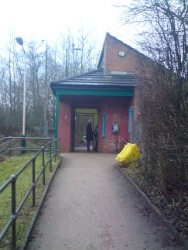 There were only two of us getting off the train from Warrington Bank Quay; me, and a woman with a pushchair, who took no time at all in lighting her fag the minute her feet hit the platform. I didn't have high hopes for Runcorn East even before I arrived. I knew that it was a relatively recent station, built in the 1980s, and as such I was fully prepared for the red brick ticket office waiting for me. I say ticket office: "hut" might be more accurate.
There were only two of us getting off the train from Warrington Bank Quay; me, and a woman with a pushchair, who took no time at all in lighting her fag the minute her feet hit the platform. I didn't have high hopes for Runcorn East even before I arrived. I knew that it was a relatively recent station, built in the 1980s, and as such I was fully prepared for the red brick ticket office waiting for me. I say ticket office: "hut" might be more accurate.
It immediately presented me with a problem. The whole point of this blog is to snap a photo of me in front of the station sign but, as far as I could tell, Runcorn East hasn't even got one. I wandered out to the roads on both sides of the tracks, and there was nothing beyond a sign on the busway to show there was even a railway station here. In the end I gave in and got a picture of me in front of the car park sign. Disappointing.
 Doubly disappointing was my lack of a top hat. In anticipation of this trip, I'd gone hunting for a top hat, so that I could give in to the Carrollian theme by dressing as the Mad Hatter. Could I find one? Could I buffalo. In retrospect, it may have been a bit of a relief, as I always look an arse fannying around in front of the signs anyway; a hat as well might have resulted in police action.
Doubly disappointing was my lack of a top hat. In anticipation of this trip, I'd gone hunting for a top hat, so that I could give in to the Carrollian theme by dressing as the Mad Hatter. Could I find one? Could I buffalo. In retrospect, it may have been a bit of a relief, as I always look an arse fannying around in front of the signs anyway; a hat as well might have resulted in police action.
Photo taken, I headed out of town in search of Daresbury. Runcorn East is sited in a deeply suburban district, all Brookside houses and cul-de-sacs. Furthermore, it's ruled by the car, so the pavement promptly disappeared for the few hundred metres it took for me to get out of the town itself and into the countryside.
There was a little hump back bridge, and then Metroland fell away and I was dropped into peaceful countryside. Wide fields, grazing cows, copses of trees. I was walking along the side of an utterly deserted lane; it felt like I was miles away from town, rather than a few yards. The only hint of the modern world was the occasional parp from a passing train.
I'd planned my route on the map, and I knew that I needed to make a turn just after crossing the railway. I kept my eyes out for a bridge, or an underpass, so I was pretty surprised to see this:
 A gate. A gate which I was expected to manually operate, doing my Green Cross Code as I crossed busy train tracks.
A gate. A gate which I was expected to manually operate, doing my Green Cross Code as I crossed busy train tracks.
I am such a wuss. I immediately had a small panic. Yes, there was a green light, but what if it changed when I was halfway across? What if it was faulty? I could be splatted across the front of a Virgin Voyager and no-one would know where I was. I hadn't even told The Bf where I was going today. And with such a quiet access road my entrails could lay there for months, being picked at by starlings, before anyone found them.
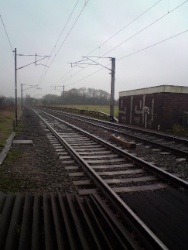 I took a deep breath and made it across the railway. I took a cheeky snap of the line, then let myself through the gate on the other side to safety. Actually, now I've written this, I don't remember closing that first gate behind me. I'm sure I must have done, but still... if your journey was disrupted because some tit left a gate open and a sheep fell under the wheels of your train, I'm deeply sorry.
I took a deep breath and made it across the railway. I took a cheeky snap of the line, then let myself through the gate on the other side to safety. Actually, now I've written this, I don't remember closing that first gate behind me. I'm sure I must have done, but still... if your journey was disrupted because some tit left a gate open and a sheep fell under the wheels of your train, I'm deeply sorry.
Beyond, there was the turn for the canal, on an aqueduct across the road. I scrambled up a dirt track, muddying the bottom of my jeans, only to reach the top and spot a nicely gravelled flight of steps further along. Whoops. Still, I was high above the fields now, with the Bridgewater Canal to follow towards the village.
"Will you walk a little faster?" said the Tart unto himself,
"There's a bracing wind about you which does wonders for your health."
See how eagerly the bullocks and the ducks all do advance!
They are waiting on the canal side - will you come and join the dance?
Will you, wo'n't you, will you, wo'n't you, will you join the dance?
Will you, wo'n't you, will you, wo'n't you, wo'n't you join the dance?
In spring last year, I walked the canal between Croston and Rufford stations. Then, it was a blue sky day, bright and gleaming. There were daffodils in the villages, there were birds singing, there were lambs in the field. I even got a tan.
This canal trip was almost exactly the opposite.
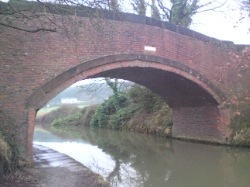 It was cold, and miserable. The fields around were muddy messes - the recent snow had clearly played havoc with them, and now they were churned up pits. There was a very vague smell of manure in the air. And all around there was that January, low feeling, grey and dark and miserable. I didn't feel like I was having a bracing walk in the country. It was a trudge. I saw only one person on the canal path, a man walking his dog, and he looked at the ground and avoided eye contact with me, while his scrappy mongrel peed on the grass.
It was cold, and miserable. The fields around were muddy messes - the recent snow had clearly played havoc with them, and now they were churned up pits. There was a very vague smell of manure in the air. And all around there was that January, low feeling, grey and dark and miserable. I didn't feel like I was having a bracing walk in the country. It was a trudge. I saw only one person on the canal path, a man walking his dog, and he looked at the ground and avoided eye contact with me, while his scrappy mongrel peed on the grass.
The English countryside is beautiful, and truly uplifting at its best. In the midst of winter it can feel desolated though. As I walked the path I could only see negatives, the bare trees, the collapsed banks with "do not moor" signs, the warnings about high voltage lines above me. It just felt so drab. Even one bright spot - a lonely piece of wildlife, a bullock on the opposite bank - took a down turn when the daft creature tried to charge me, before realising I was on the other side of the water. Seems even the cattle were looking for a distraction.
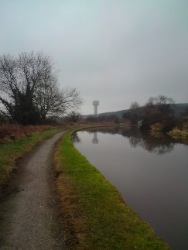 And in the distance, incongruous, alien, was the Daresbury Tower, centrepiece of the former Nuclear Physics Laboratory. It poked out of the tree line like a sentinel, watching silently over the fields around it. As I got closer, it looked no less odd; the thick concrete, the circular form, the lack of windows - it wasn't designed for men, but instead for science.
And in the distance, incongruous, alien, was the Daresbury Tower, centrepiece of the former Nuclear Physics Laboratory. It poked out of the tree line like a sentinel, watching silently over the fields around it. As I got closer, it looked no less odd; the thick concrete, the circular form, the lack of windows - it wasn't designed for men, but instead for science.
I'd originally planned on cutting across to Daresbury through a woodland, but it was so grim and wet, I abandoned that idea and instead headed in through the Technology Park itself. The buildings by the canal looked utilitarian and 1960s Ministry of Works designed; only on the other side of the road were their 21st Century counterparts allowed to have a bit of glass and steel and shine to them.
 Across a busy bypass, and I was finally in the village itself. I'd begun to flag, if I'm honest, with the long dispiriting walk, but the village sign gave me a quick pep, especially when I spotted the church immediately. Dodgson's father was the reverend here, and the writer was born in the vicarage (sadly the building has subsequently burnt down). He lived here until he was eleven, when the whole family decamped to Yorkshire to follow his father to another parish.
Across a busy bypass, and I was finally in the village itself. I'd begun to flag, if I'm honest, with the long dispiriting walk, but the village sign gave me a quick pep, especially when I spotted the church immediately. Dodgson's father was the reverend here, and the writer was born in the vicarage (sadly the building has subsequently burnt down). He lived here until he was eleven, when the whole family decamped to Yorkshire to follow his father to another parish.
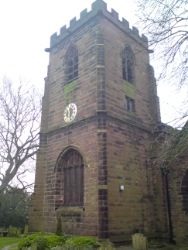 Thankfully, All Saint's Church was open; I don't know what I would have done if it hadn't been. I was here, not just to see the place where the young Dodgson had worshipped, but also to see the famous Lewis Carroll window there. To celebrate the centenary of his birth, artist Geoffrey Webb designed a stained glass window which not only featured the birth of Christ, but also images of Carroll himself, Alice, and some of the creatures she encountered in Wonderland.
Thankfully, All Saint's Church was open; I don't know what I would have done if it hadn't been. I was here, not just to see the place where the young Dodgson had worshipped, but also to see the famous Lewis Carroll window there. To celebrate the centenary of his birth, artist Geoffrey Webb designed a stained glass window which not only featured the birth of Christ, but also images of Carroll himself, Alice, and some of the creatures she encountered in Wonderland.
I took a pew, just to have a breather, and watched a sturdily built woman Mr Sheen the tops of the seats. I was the only other person in there, and I was able to stare at the pretty interior of the church. It was light and airy and warm, and clearly well cared for.
You'll have to take my word on all this though. I should have guessed something was up by the Gift Aid envelopes in the spot on the pews where a Bible normally rests:
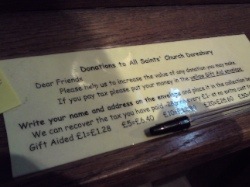 I know these are hard times for everyone, but that just seemed a bit, well, crass. I slipped some money inside and donated anyway, because I do believe in contributing to maintain buildings like these, even if I don't totally agree with the purpose they're used for. I dropped it in the donation box, then turned back into the church to take a few photos.
I know these are hard times for everyone, but that just seemed a bit, well, crass. I slipped some money inside and donated anyway, because I do believe in contributing to maintain buildings like these, even if I don't totally agree with the purpose they're used for. I dropped it in the donation box, then turned back into the church to take a few photos.
The hefty woman was watching me over the top of her tin of polish, and I realised why. Printed using brightly coloured MS Word Art was a sign on the nearest pillar: To take photographs, please pay £2 to the Church Steward.
No wonder she was keeping an eye on me! She didn't want me to whip out my Instamatic without paying. It didn't matter that I'd just dropped a contribution into the donation box; I'd have to pay more for the privilege of taking a shot of the roof. Stuff that, I thought, and headed down one of the side aisles towards a little ante-room. Balanced on the pews to my side were jams, jellies, books; all sorts of carefully arranged goodies, with LOCAL PRODUCE word processed above them.
I'm not really up on Church architecture, so all I can say is that the Alice Window was located inside a windowed chamber with an altar inside, a sort of chapel within the church. I was looking for the door in when I saw another sign: ALICE IN WONDERLAND WINDOW. To take photographs or videos of the window you will need to obtain a personal licence. This will cost £2 and can be obtained from the Church Stewards.
Stuff that, again! I was enraged at being so shamelessly gouged by what was supposedly a place of worship. I gave the woman an indignant purse of my lips and marched out of the church, mentally muttering something about "moneylenders in the temple" and so on.
Instead I went round the back of the church, and now I can present to you a picture of the rear of the Alice window, obtained for zero pounds:
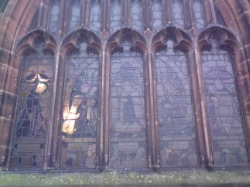 In your face, Christianity! (You can see a picture of the front here.)
In your face, Christianity! (You can see a picture of the front here.)
If every pub in every land
Were closed for half a year,
Do you suppose that I could go
That long without a beer?
"I doubt it," said the Merseytart,
And shed a bitter tear.
Observant readers might have noticed my multiple chins in my photos. Yup, I'm overweight, and so I've trimmed my diet. I now eat less, mainly soup and salad, and I've cut out booze more or less altogether. No more bottles of wine on a Saturday night; no more bottles of wine on a Friday night; no more cheeky pints while I watch Corrie. Just fruit juice and tea for me now. (Exception: special occasions and social circumstances).
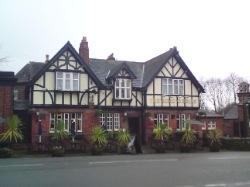 This should be fine but, dear reader, I'm weak. So when I walked out of the church and needed fortifying before leaving the village, I was naturally drawn towards the pub, just across the way: the Ring O' Bells. "It's the 21st Century, and that's a pub/restaurant," I lied to myself. "You can just go in and have a coffee, and perhaps a small sandwich to keep you ticking over."
This should be fine but, dear reader, I'm weak. So when I walked out of the church and needed fortifying before leaving the village, I was naturally drawn towards the pub, just across the way: the Ring O' Bells. "It's the 21st Century, and that's a pub/restaurant," I lied to myself. "You can just go in and have a coffee, and perhaps a small sandwich to keep you ticking over."
 Ahem.
Ahem.
Two pints of bitter and a chicken burger later, I rolled back out of the Ring O' Bells and into the street. I hate going back on myself; I like to always go somewhere different, but there really wasn't a different way to get back to Runcorn East. I'd have to go back the way I came. And, as I've already indicated, it was pretty drab the first time round. A return trip would perhaps have seen me taking a dive into the canal to end it all.
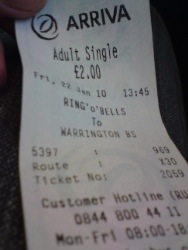 There was only one thing for it. I was going to have to take a bus. A wild and crazy bus ride, where the driver took quite terrifying turns round corners, skipped stops at random, and burnt up the dual carriageways on the way back to Warrington. It was sort of appropriate that I'd gone to pay homage to Lewis Carroll, and ended up on a vehicular version of Alice's run with the Red Queen. We finally swung into the bay at Warrington bus station, and I could dismount, swallowing down the pints of bitter that were trying to make a return trip up my gullet and remembering why I never take buses.
There was only one thing for it. I was going to have to take a bus. A wild and crazy bus ride, where the driver took quite terrifying turns round corners, skipped stops at random, and burnt up the dual carriageways on the way back to Warrington. It was sort of appropriate that I'd gone to pay homage to Lewis Carroll, and ended up on a vehicular version of Alice's run with the Red Queen. We finally swung into the bay at Warrington bus station, and I could dismount, swallowing down the pints of bitter that were trying to make a return trip up my gullet and remembering why I never take buses.
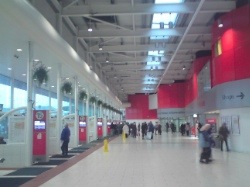 Fortunately, Warrington bus station is a joy. Really. Bright and airy, well maintained and user friendly. Ok, it's clearly brand spanking new - Preston bus station probably looked the same when it first opened - but it was nice to be in a shiny transport interchange with plasma screens and a cafe that didn't look like it'd give you dysentery. If more bus stations looked like this, more people would use their services. (Plus if the bus drivers weren't speed demons it would help).
Fortunately, Warrington bus station is a joy. Really. Bright and airy, well maintained and user friendly. Ok, it's clearly brand spanking new - Preston bus station probably looked the same when it first opened - but it was nice to be in a shiny transport interchange with plasma screens and a cafe that didn't look like it'd give you dysentery. If more bus stations looked like this, more people would use their services. (Plus if the bus drivers weren't speed demons it would help).
 On the far wall of the station is a memorial to the old Liverpool & Manchester Railway, as well as the local canal; a nice little touch of history in the gleaming 21st Century world of the bus station. I took a photo, then headed off to Warrington Central, ready for a train away from Wonderland and off to boring old reality.
On the far wall of the station is a memorial to the old Liverpool & Manchester Railway, as well as the local canal; a nice little touch of history in the gleaming 21st Century world of the bus station. I took a photo, then headed off to Warrington Central, ready for a train away from Wonderland and off to boring old reality.
"And hast though caught three stations now?
"Come to my arms, my beamish boy!
"O frabjous day! Callooh! Callay!"
He chortled in his joy.
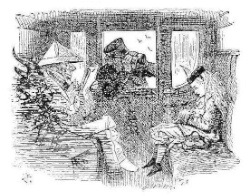 P.S. I felt bad for not having the top hat on at Runcorn East, therefore depriving me of a Lewis Carroll related pic. Then it occurred to me:
P.S. I felt bad for not having the top hat on at Runcorn East, therefore depriving me of a Lewis Carroll related pic. Then it occurred to me:
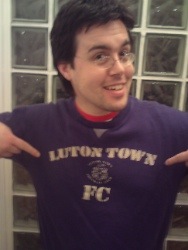 It's me, pulling a stupid face, while wearing a Luton Town FC shirt. I am, quite literally, a MAD HATTER.
It's me, pulling a stupid face, while wearing a Luton Town FC shirt. I am, quite literally, a MAD HATTER.
Oh, please yourselves.
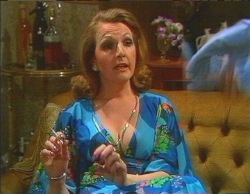 Prepare yourself for some snobbishness of galactic proportions. You may have noticed before that I really enjoyed the First Class experience on my way down to London - you'd have had to read between the lines, it was so subtle, but it was there. Well, I'm now on the train home, and it's a Sunday, so there are people on here taking advantage of the £15 upgrade to the posh seats.
Prepare yourself for some snobbishness of galactic proportions. You may have noticed before that I really enjoyed the First Class experience on my way down to London - you'd have had to read between the lines, it was so subtle, but it was there. Well, I'm now on the train home, and it's a Sunday, so there are people on here taking advantage of the £15 upgrade to the posh seats. 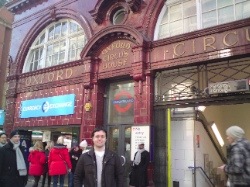 What's impressive about the network, just from my last visit about eighteen months ago, is how much the stations have been tidied and cleaned. The tiles gleam in the passageways and platforms, white and shining, reflecting back the new lighting and almost iridescent. There are now LCD screens on the escalators, flashing moving video adverts at you, and projectors at Oxford Circus beamed full commercials onto the wall across from the platform. And of course, there's electronic information signs, and ticket machines, and gates at every station. It shows the cash that has been pumped into the network since Ken took over (I consider Boris to be just continuing with Livingstone's legacy). I can't wait until the new trains start arriving, and Crossrail finally comes to fruition...
What's impressive about the network, just from my last visit about eighteen months ago, is how much the stations have been tidied and cleaned. The tiles gleam in the passageways and platforms, white and shining, reflecting back the new lighting and almost iridescent. There are now LCD screens on the escalators, flashing moving video adverts at you, and projectors at Oxford Circus beamed full commercials onto the wall across from the platform. And of course, there's electronic information signs, and ticket machines, and gates at every station. It shows the cash that has been pumped into the network since Ken took over (I consider Boris to be just continuing with Livingstone's legacy). I can't wait until the new trains start arriving, and Crossrail finally comes to fruition...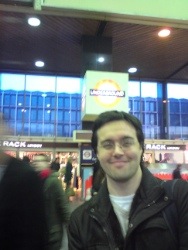 Final stop on my whistle-stop Underground tour was Euston. I did go to Holborn (nice murals of the British Museum, freshly scrubbed) and Embankment (as dowdy as it always has been, sadly) but I forgot to take snaps there. So instead you'll have to see my chirpy smirk on the concourse at Euston. It's that rarest of buildings: a railway terminus which is completely devoid of any charm or class. It's an Arndale Centre and, like those misguided shopping hellholes, it's a period of architecture which everyone wishes had never happened. Even though it's barely forty years old, there are already plans for it to be replaced within the next decade - plans which will probably make it even more soulless than before, and turn it into a mall with pretensions. That it exists down the road from the awe inspiring St Pancras and the grubby but fun King's Cross just rubs salt into the wound.
Final stop on my whistle-stop Underground tour was Euston. I did go to Holborn (nice murals of the British Museum, freshly scrubbed) and Embankment (as dowdy as it always has been, sadly) but I forgot to take snaps there. So instead you'll have to see my chirpy smirk on the concourse at Euston. It's that rarest of buildings: a railway terminus which is completely devoid of any charm or class. It's an Arndale Centre and, like those misguided shopping hellholes, it's a period of architecture which everyone wishes had never happened. Even though it's barely forty years old, there are already plans for it to be replaced within the next decade - plans which will probably make it even more soulless than before, and turn it into a mall with pretensions. That it exists down the road from the awe inspiring St Pancras and the grubby but fun King's Cross just rubs salt into the wound. Fortunately the First Class lounge at Euston is resolutely 21st Century, and is like the Lime Street one, only x100. There's less Swedish sauna pine, admittedly, but plenty of leather banquettes and plasma screens showing the BBC News channel (though one screen was tuned to Songs of Praise, for some reason). There's even a charging station, which lets you plug in your mobile and get it powered up while you enjoy the facilities.
Fortunately the First Class lounge at Euston is resolutely 21st Century, and is like the Lime Street one, only x100. There's less Swedish sauna pine, admittedly, but plenty of leather banquettes and plasma screens showing the BBC News channel (though one screen was tuned to Songs of Praise, for some reason). There's even a charging station, which lets you plug in your mobile and get it powered up while you enjoy the facilities.
